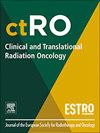Prostate radiotherapy in patients with metastatic hormone-sensitive prostate cancer: A systematic review and meta-analysis of randomised controlled trials
IF 2.7
3区 医学
Q3 ONCOLOGY
引用次数: 0
Abstract
Introduction
The incidence of synchronous metastatic hormone-sensitive prostate cancer (mHSPC) is rising with the increasing use of next-generation imaging. Local radiotherapy (RT) was shown to improve survival in patients with mHSPC; however, new data require a re-assessment of the indication and value of local RT in mHSPC.
Methods
In this prospectively registered systematic review and meta-analysis (CRD42025648251), we searched MEDLINE, Scopus, CENTRAL, and Google Scholar in March 2025 for phase 3 RCTs evaluating the addition of RT to systemic therapy to improve OS in mHSPC patients. Hazard ratios (HRs) were pooled using random-effects meta-analysis. Risk of Bias was assessed with Cochrane’s RoB 2 tool.
Results
Out of the 10,615 individual records, we identified three RCTs: HORRAD (n = 432), STAMPEDE (n = 2,061), and PEACE-1 (n = 1,173). The systemic treatment included androgen deprivation therapy (ADT) in HORRAD, ADT ± Docetaxel in STAMPEDE, and ADT ± Docetaxel ± Abiraterone in PEACE-1 trial. Local RT was not associated with significantly improved OS in all patients (HR = 0.92; 95 % confidence interval [CI] 0.85–1.00; p = 0.06), or in those with low metastatic burden (HR = 0.74; 95 %CI 0.51–1.06; p = 0.1); however, exploratory analyses showed a significant improvement in androgen deprivation resistance-free survival (HR = 0.76; 95 %CI 0.70–0.82; p < 0.001). Local RT was associated with significant reduction in local prostate cancer related events in the HORRAD (18 % vs. 30 %) and PEACE-1 (12 % vs. 22 %) trials, but not in the STAMPEDE trial (49 % vs. 51 %).
Conclusion
Local RT does not improve OS in unselected patients treated with modern systemic therapies for mHSPC. However, it delays ADT resistance and reduces local adverse events, with relatively tolerable toxicity. Future studies should refine selection criteria, ideally using PSMA-PET imaging, dynamic response markers, and/or genomic profiling, to identify mHSPC patients most likely to benefit from local RT.
转移性激素敏感前列腺癌患者的前列腺放疗:随机对照试验的系统回顾和荟萃分析
同步转移性激素敏感前列腺癌(mHSPC)的发病率随着下一代成像技术的使用越来越多而上升。局部放疗(RT)可改善mHSPC患者的生存;然而,新的数据需要重新评估mHSPC的适应症和局部RT的价值。方法在这项前瞻性注册的系统评价和荟萃分析(CRD42025648251)中,我们于2025年3月检索了MEDLINE、Scopus、CENTRAL和谷歌Scholar,以评估在全身治疗中增加RT治疗以改善mHSPC患者的OS的3期rct。采用随机效应荟萃分析合并风险比(hr)。采用Cochrane的RoB 2工具评估偏倚风险。结果在10615个个体记录中,我们确定了3个随机对照试验:HORRAD (n = 432)、STAMPEDE (n = 2061)和PEACE-1 (n = 1173)。全身治疗包括:HORRAD组ADT±多西他赛,STAMPEDE组ADT±多西他赛,PEACE-1组ADT±多西他赛±阿比龙。所有患者的局部放疗与OS的显著改善无关(HR = 0.92;95%置信区间[CI] 0.85-1.00;p = 0.06),或低转移负荷患者(HR = 0.74;95% ci 0.51-1.06;p = 0.1);然而,探索性分析显示,雄激素剥夺无抵抗生存显著改善(HR = 0.76;95% ci 0.70-0.82;p & lt;0.001)。在HORRAD试验(18%对30%)和PEACE-1试验(12%对22%)中,局部放疗与局部前列腺癌相关事件的显著减少相关,但在STAMPEDE试验中没有(49%对51%)。结论局部放疗不能改善未选择的mHSPC现代全身治疗患者的OS。然而,它延缓了ADT耐药性,减少了局部不良事件,毒性相对可耐受。未来的研究应该完善选择标准,理想情况下使用PSMA-PET成像,动态反应标记物和/或基因组分析,以确定mHSPC患者最有可能从局部RT中受益。
本文章由计算机程序翻译,如有差异,请以英文原文为准。
求助全文
约1分钟内获得全文
求助全文
来源期刊

Clinical and Translational Radiation Oncology
Medicine-Radiology, Nuclear Medicine and Imaging
CiteScore
5.30
自引率
3.20%
发文量
114
审稿时长
40 days
 求助内容:
求助内容: 应助结果提醒方式:
应助结果提醒方式:


